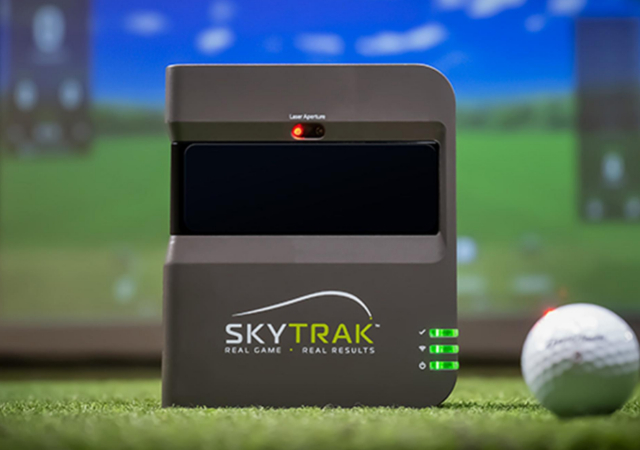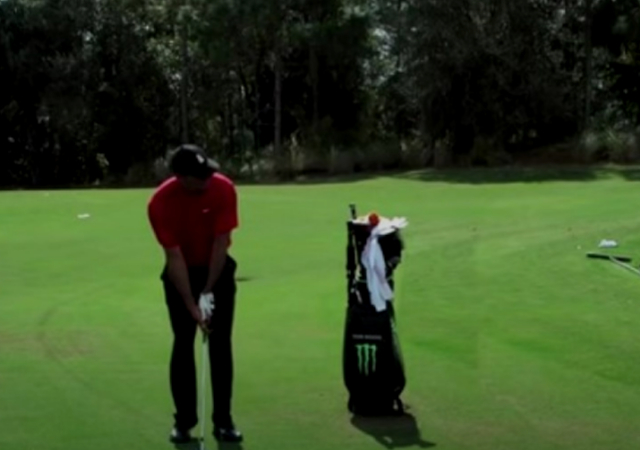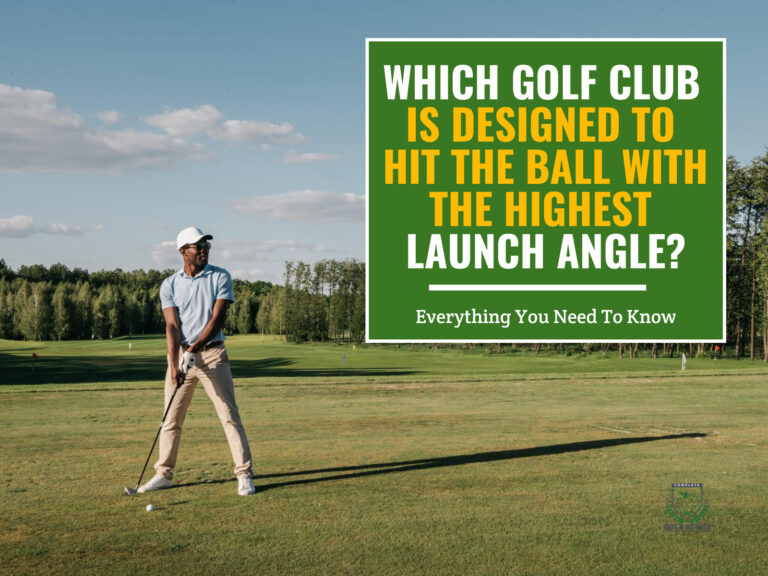Some golf club designs focus on achieving the best shot and launch angle. In this post, we will find out which club is designed to launch the ball with the highest angle. We have reviewed the performance and characteristics of dozens of golf club models to find the top-performing ones.
Launch angle changes depending on the club being used, how the ball is struck, and even the weather. In this post, we tried to answer your query about the type of Golf club that helps achieve higher launch angles.
- 1) Which Golf Club is Designed to Hit the Ball with the Highest Launch Angle?
- 2) What is Launch Angle?
- 3) The Importance of Launch Angle
- 4) What is Loft, and Why Does it Matter?
- 5) How Does Launch Angle and Loft Relate?
- 6) Wedges With The Highest Loft
- 7) How does Launch Angle Affect How The Ball Lands?
- 8) Tips to Control Your Launch Angle
- 9) Conclusion
Which Golf Club is Designed to Hit the Ball with the Highest Launch Angle?

Wedges, particularly lob wedges, are the clubs designed to hit the ball with the highest launch angle.
Wedges are already known as ‘lofted clubs’ or clubs with ‘high lofts.’ They are primarily used to hit the golf ball high up in the air and quickly bring it back on the green. If the distance between the hole and your hitting area is not greater than 125 yards, you must choose a wedge. It strictly is not a distance club. The lofts on the wedges range from around 50° for gap wedges, and for a lob wedge, it is a 60° loft which is the highest among all golf clubs.
The lob wedge is useful when you want to hit the ball higher. It has a lofted face and a slightly thicker blade than other clubs.
One of the reasons why these clubs are so effective is because the club head has a larger face. This gives you more room for spin. They also allow you to perform a full swing and they are very forgiving for beginners as described in our guide. They can help land the ball on the green better.
Lob wedges don’t need any other endorsement when some of the best players in the world own them. For example, Rory Mcilroy holds several sets of wedges. Tiger Woods also has quite a few of them.
What is Launch Angle?
In the golf world, launch angle has become the number one concern when it comes to how well the golf ball will fly off the clubface.
A lot of new technology like different types of launch monitors in this area have been invented, and even some great old clubs have undergone modifications to allow for a better launch. One modern technology used in launch monitors is the radar technology to read the launch conditions, ball speed, spin rate and other important factors during the Golf shot.

Launch angle refers to the angle of the ball when it leaves the club (right after the impact) relative to the ground. For an ideal shot with a driver, the launch angle should be 15° to 17°.
The Importance of Launch Angle
If you’re a serious golfer, you probably already know the importance of launch angle in golf. It is the angle at which the ball leaves the club face after impact. A higher launch angle for golfers with low to medium swing speeds helps in a greater ball flight distance. Achieving a higher launch angle is particularly important when facing uphill, as the ball can fly more efficiently.
What is Loft, and Why Does it Matter?
Loft is the distance between the toe line and the bottom of the club. It is measured in degrees. A high-lofted wedge has a higher angle of loft than a low-lofted wedge. Low-lofted wedges are usually used for approach shots 110 to 120 yards away from the green whereas high-lofted wedges are designed to get the ball quickly in the air.
The basic idea behind lofts is that the player can use a little backspin on the ball so it does not move forward on the green. In addition, the golfer should aim slightly down the line and swing their arms just over shoulder height. The shoulders must face the target when the hands meet at the top of the stroke. The result is that the ball travels a shorter distance.
How Does Launch Angle and Loft Relate?

The launch angle depends on the club loft and the swing speed of the players. The difference in launch angle of different clubs is mainly due to loft, combined with the varied clubhead and swing speeds.
The club face has an angle that is relative to the horizontal plane which is called the loft (or loft angle). When the club head rises, the club face is at a lower angle, and the ball flies higher.
For a player with a slow to medium swing speed, a higher loft will help launch the ball higher (higher launch angle) and achieve longer distances than those with a lower loft.
However, for players with higher swing speeds, a higher loft angle will result in a too high launch angle and may negatively affect the distance coverage. This is because the ball will ascend and descend in a sharper and more vertical angle.
Wedges With The Highest Loft
Besides a lob wedge, we have some more clubs to bring to our list of highest lofted clubs which are also known as wedges. Despite the manufacturing of tech-savvy clubs, playing wedge shots can never get old. Calling them gold yet old is not an exaggeration.
Sand Wedge
You can get stuck in a sand trap anytime in your golf game. That’s why keeping all types of clubs in your bag is advised.
Sand wedge, true to its name, helps you to get out of a sand trap situation. They are lofted between 54 and 58 degrees and so help the golfers hit about 80-100 yards. Professional golfers choose them for clubs covering perfect distances.
Gap Wedge

With an angle of about 50° to 52°, Gap Wedge or G Wedge is true to its name. It falls in between the two categories of the sand wedge and pitching wedge.
Manufacturers call it an approach wedge too. A gap wedge helps a ball go lower and longer than a sand wedge and has a higher and shorter trajectory than a pitching wedge—the distance covered is between 75 to 100 yards.
Pitching Wedge

Beginners usually use a pitching wedge for practice shots. This is because they have the lowest loft among the wedges, i.e., about 46° to 50°, which takes the ball to the farthest distance possible. Golfers have noted their distances with the pitching wedges to go as far as 120 yards.
PW or pitching wedges may be an excellent choice for chipping around the greens.
How does Launch Angle Affect How The Ball Lands?
Launching the ball with a low trajectory, i.e, a more downward ball flight path, is very effective in delivering maximum distance due to more roll distance when the ball lands. So, in our case, we should choose to launch the ball with a higher launch angle. As a result, the ball will ultimately go higher and cover a lower distance because of a more vertical landing resulting in less roll.
Tips to Control Your Launch Angle
Your launch angle must be one of the prerequisites for a great shot. Here are some tips for raising or lowering your launch angle.
Shoulder Position:
Your shoulder tilt is indirectly proportional to the launch angle. Therefore, you should bring your shoulder downward if you want to raise your launch angle. Conversely, tilting your shoulder upward would allow a lower launch angle.

Are you Teeing Your Ball Correctly?
You should try to tee the ball a little lower for a lower launch angle. A highly teed ball will increase the launch angle.
Play With Your Ball Position
Hit the ball a little back in your stance, decreasing your attack angle and lowering your launch angle.
Conversely, if you want to raise your launch angle, play the ball toward the ankle of your front foot.
Get Drivers with Adjustable Lofts
Your new driver and its little companion to help you adjust the degrees of loft would be the best bet. You can quickly increase or decrease your launch angle with adjustable lofts up to 12 degrees
Conclusion
You might have understood by now how important it is to keep different types of clubs in your bag every time. For example, a Lob Wedge will be there for a short-distance target, while a Sand wedge would take you out of a sand trap situation.
On the other hand, the Irons with regular lofts are of great importance to your long-distance shots.
If you are a beginner, you would have increased your knowledge about loft and launch angle via this article. We wish you success in your future; if you follow our sincere advice, you will surely become a successful golfer.





